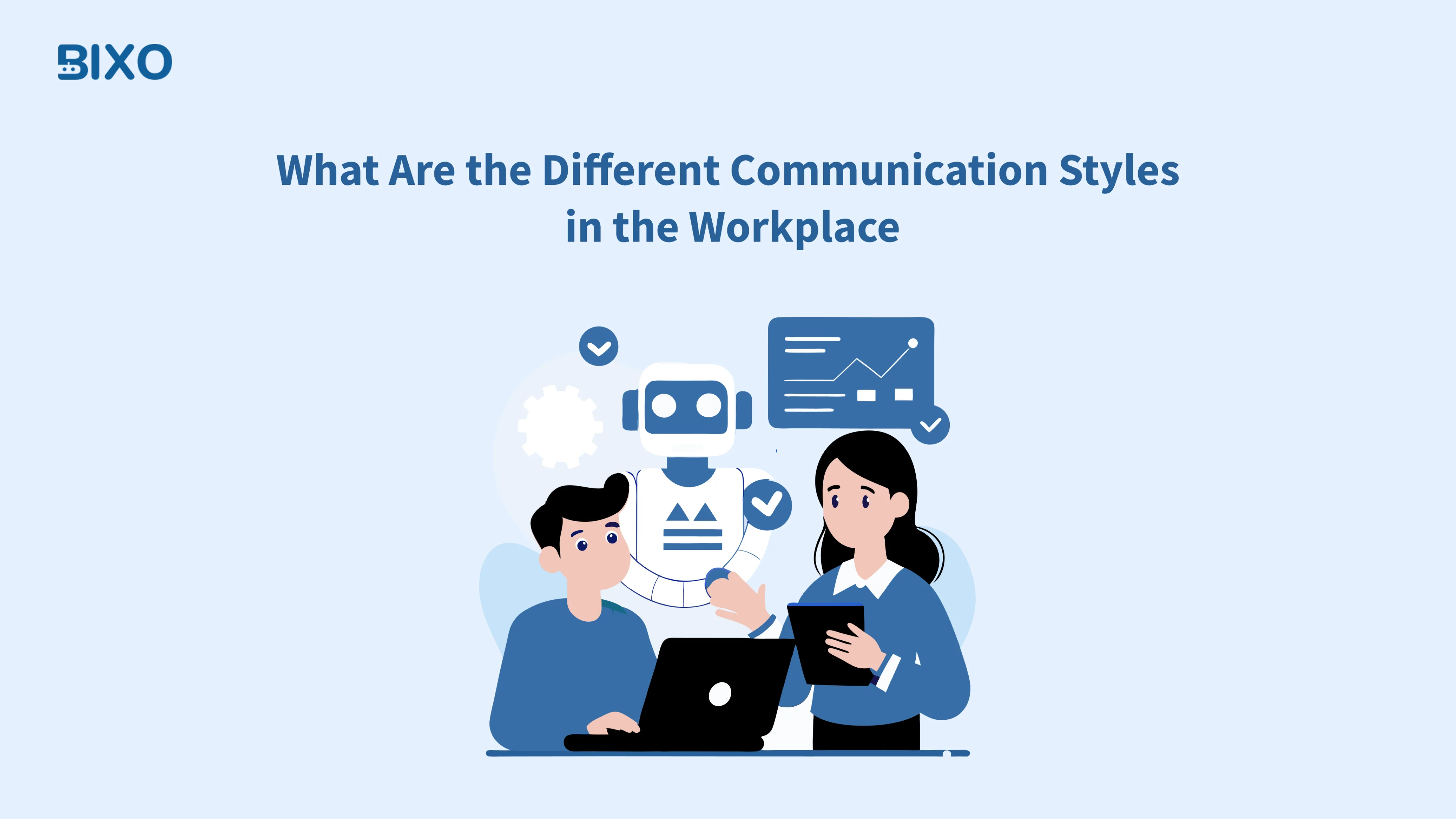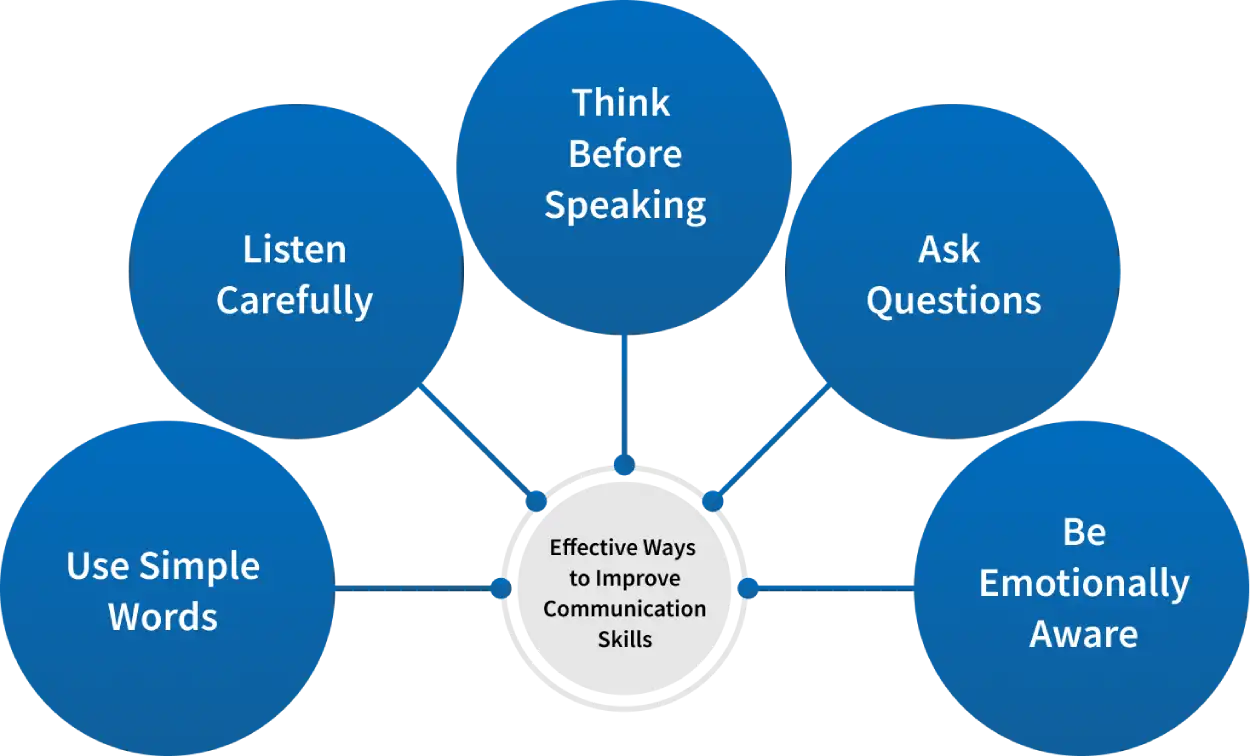
Table of Content
Focus on what matters. BIXO handles the rest!

Everyone has their own way of talking and listening, and that’s perfectly normal. At work, you’ll notice these differences in meetings, emails, or even quick hallway chats. Some people speak their mind right away, while others like to pause and think before they share. Some focus on facts, and others pay more attention to feelings.
When you understand these styles, it becomes easier for you to work with your team. You’ll notice how your teammates like to communicate and can adjust your approach so everyone understands each other and the team works better. In this blog, you’ll learn about the main communication styles in the workplace and get practical tips on working effectively with each one.
What Are Communication Styles?
A communication style is how you share your thoughts and feelings with others. It is not just the words you express but the manner which will be expressed by your tone, movements, eyes, and body language. These little signals can often speak louder than words and show others how you truly feel.Everyone has their own way of expressing themselves. Some people get straight to the point, while others take time to open up. These differences shape your unique communication style.
You use your communication style every day in face-to-face conversations, written messages, or even online chats. When you understand your own style and are able to understand how a person can communicate, it will be much easier to relate well, prevent misunderstandings and establish better collaboration in teams .
Why Are Communication Styles Important?
In the teamwork, communication plays a key role in how smoothly things run. When people don’t fully understand each other, things can quickly get off track. Time becomes slow, errors begin to appear, and frustration develops.
The truth is, everyone has their own way of talking and listening. When styles don’t match, even small talk can feel complicated.
Here’s why understanding your communication style really matters:
- Reduces the chances of misunderstanding and miscommunication
- Improves the productivity with your team and peers
- Makes teamwork easier and respectable
- Boosts productivity and team morale
What Are the 4 Types of Communication Styles?
People communicate in different ways, and usually, we follow one of four common styles. These styles affect the way you talk to others, respond in conversations and even the way you handle conflict or stress. When you understand the differences, it becomes easier to express yourself clearly and understand others without things getting awkward or tense.
Here are the four main communication styles you’ll come across:

Passive
Passive communicators usually stay quiet and let others take charge. They avoid speaking up, especially in difficult situations, and often keep their true thoughts and feelings to themselves. People like this often seem quiet and go along with what others say.
Imagine you’re in a team meeting at work. There’s someone like Ravi who rarely shares his ideas or concerns. Even if he thinks the team should take a different approach, he stays silent and agrees with whatever the group decides. He doesn’t want to cause conflict or disagreement, so he just goes along with the majority.
Aggressive
A person with this communication style is very sure of their opinions and often doesn’t pay attention to what others are saying. They tend to speak at people, interrupt, or say harsh things like “you’re wrong” or “that’s not right.” This can make others feel suppressed or nervous, particularly in group meetings. You may notice crossed arms, a serious tone, or firm eye contact, all signs that they are focused on being correct rather than listening to others.
Think about a team meeting where one person keeps talking and doesn’t let others join in. Whenever someone tries to share an idea, they jump in with their own. They may not realise it, but it feels like they aren’t really listening. This often makes the rest of the team feel uncomfortable or stay quiet.
Passive-Aggressive
A person with this communication style doesn’t say what they really feel directly. They don’t want to cause a fight, so they keep their true feelings to themselves but still express them quietly. Instead, they may accept and then express their frustration in other ways, like making jokes with an underlying meaning or refusing to do things. They don’t want to cause a fight, so they keep their true feelings to themselves but still express them quietly.
Imagine a group project where one person agrees to do the task nobody wants, but later keeps avoiding it or quietly tells others they don’t enjoy it. They never say it openly, but it’s clear they aren’t happy with the work.
Assertive
A person with this communication style clearly shares his thoughts and feelings while respecting others. They speak honestly and directly but stay calm and polite. They listen to others and try to find a solution that works for everyone. Their body language is open and friendly. They make eye contact and stay relaxed while talking.
Imagine a team meeting where someone speaks up and shares their ideas, but also pays attention to what others are saying. They explain their thoughts clearly and respect what others say. This kind of attitude makes everyone feel good and helps the team work better together.
How Do You Identify Communication Styles?
You don’t need a degree to understand how someone communicates. Most of the time, it’s easy to identify in how they speak, their body language, and how they respond when you talk. Paying attention to these small signs can help you understand people better and connect with them more easily.
Some people get straight to the point, while others take time to warm up. Watching how someone communicates can make it easier to connect and have meaningful conversations.
Here are some easy methods of identifying various communication styles:

Observe Behaviour
Pay attention to how people behave in different situations, whether in meetings, casual chats, or when things get stressful. Notice how they respond to questions and challenges. Small actions and reactions can give you a clear sense of their communication style.
Tone and Language
Listen carefully to the words they choose and how they say them. Are they casual, formal, friendly, or direct? Understanding their tone and language helps you connect with them naturally and have smoother conversations.
Decision-Making Style
Watch how people make decisions and handle choices. Some rely on facts and logic, while others trust their instincts or experience. Knowing their approach helps you communicate your ideas in a way that makes sense to them.
Body Language Signals
Observe gestures, facial expressions, eye contact, and posture. Leaning forward can show interest, while crossed arms may indicate hesitation. Reading these signals gives you insight into how engaged and comfortable someone feels.
Encourage Open Dialogue
Invite people to share their thoughts openly and ask questions regularly. Let them communicate in the way they feel most comfortable, like chat, calls, or meetings. Open dialogue builds trust, improves understanding, and makes everyone feel valued.
Common Communication Mistakes to Avoid
You talk every day, but sometimes little things can cause problems or hurt someone’s feelings. Knowing these common mistakes can help you talk better and get along with others.
Here are five common mistakes to avoid:
- Assuming Things: Don’t assume and guess what someone means. Ask questions if you are not sure.
- Ignoring Body Language: Sometimes people express more with their facial expressions or how they are sitting than what they actually say. Unless you observe these minor expressions, you may not get to know how they really feel.
- Being Unclear: If you are not clear in your explanation, people might not get it.
- Not Listening Properly: If you are thinking of what to say next, you may not hear what that person is saying.
- Interrupting: When you talk over someone, this makes them feel that you are not really interested in what they are talking about.
How to Improve Your Communication Skills?
Being a good communicator doesn't mean using complex words or raising your voice. It’s really about connecting with people, making sure they feel heard, understood, and respected. It does not matter if you are talking to a teammate, manager, or friend; a few minor adjustments can help ensure that you are effectively communicating and avoid miscommunication.
Here are some simple ways to improve your communication skills:

- Keep Your Words Simple and Clear You don’t need big or complicated words to share your point. Just be clear, honest, and speak in a way that others can easily understand.
- Listen with Full Attention When someone is talking to you, give them your full attention. Put your phone down and actually look at the person, and be sure you're trying to understand what they are saying. People can tell when you are actually listening.
- Think Before You Speak Before jumping into a reply, take a minute to gather your thoughts. A minute of silence can only help you stay calm and express yourself more clearly, especially in difficult situations.
- Ask If You’re Unsure When you do not understand something, simply ask. Guessing is worse than clarification. When you ask questions, you give a sign that you listen and care about doing things correctly.
- Practice Emotional Intelligence Be aware of how other people feel in the conversation. Change your tone and attitude to keep the discussion friendly and respectful.
Improve Team Collaboration and Communication with BIXO
Communication can get complicated when team members have different ways of sharing information. One person prefers quick updates, another sends long emails with all the details, and someone else may need reminders to complete tasks. Understanding these differences can help prevent confusion and keep the team on track.
BIXO makes teamwork easier by tracking all your conversations, tasks, and notifications in one place, so nothing gets missed. It keeps every team member on the same page, whether they’re quiet or outspoken. With simple reminders and progress tracking, the team can get more done together. BIXO helps your team communicate clearly, stay organised, and reach goals faster.

Conclusion
When you pay attention to how people talk and listen every day, it’s easier to work together and avoid confusion. You don’t have to change who you are, just be a little more mindful of how you speak and listen. When everyone understands each other, working as a team feels easy. And with BIXO by your side, clear and smooth communication is just a step away.
FAQs
Yes, you can adopt various communication styles according to circumstances or the people you are with.
Assertive communication is generally the most balanced, but the best style depends on the situation. Sometimes being more passive or more direct may help, depending on what the moment calls for.
Yes, you can adjust your communication style according to situations and people.
Passive communication is something where you hold yourself back to stay out of trouble. And assertive communication is the expression of how you feel without being rude.





